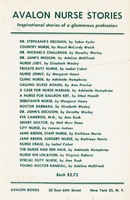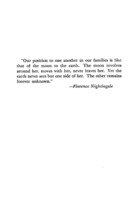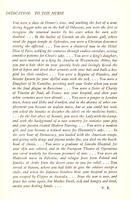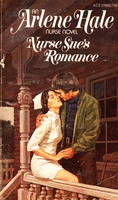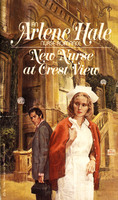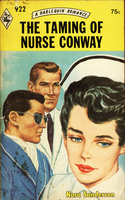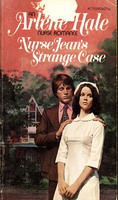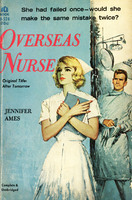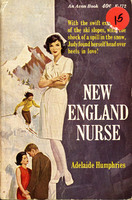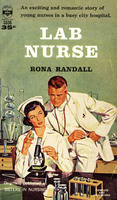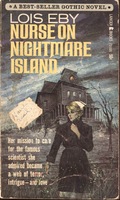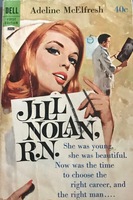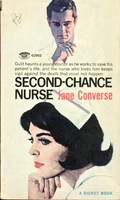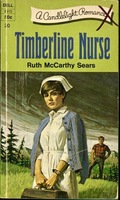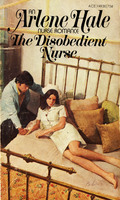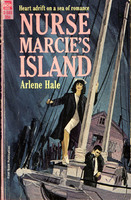More than a Narrative: Paratexts of Nurse Romance Novels
What are paratexts?
Literary theorist Gérard Genette coined the term "paratext" in his book Paratexts: Thresholds of Interpretation. He proposed that the elements that surround a narrative or primary text function individually and in conjunction with the author's primary textual content to create the book. These elements all play an important role in a book's presentation and mediation:
"Paratexts are those liminal devices and conventions, both within and outside the book, that form part of the complex mediation between book, author, publisher, and reader: titles, forewards, epigraphs, and publisher's jacket copy are part of a book's private and public history."
Nurse romance novels are filled with interesting paratextual elements: eye-catching cover art, saccharine cover captions, and sensational summaries that grace their flyleaves. Non-fiction works also have interesting paratexts: dedication pages of nursing biographies or prefaces to nursing textbooks. Observing patterns or anomolies in paratexts can raise good research questions, as can the process of trying to historically contextualize the functions of paratextual elements. For example, the titles and cover art of nurse romance novels often changed when romance titles went through reprints. In Harlequin's early years, their only romances were reprints of titles already published by British publisher Mills & Boon—they commonly changed the titles, cover art, and jacket summaries to cater to a North American audience. What could be learned by comparing these versions?
Be sure to click each image to open up a lightbox gallery with more examples, images, and quotes!
Judging a Book By Its Cover
As Jennifer McKnight-Trontz asserted in her book, The Look of Love: The Art of the Romance Novel, “An entire genre of fiction was sold based on the premise that one could, in fact, tell a book by its cover.”
During the mid 20th century famous graphic designers and artists created the illustrations for the covers of mass market paperbacks, whether westerns, mysteries, or romances. In collaboration with publishers, these artists established unique and recognizable aesthetics for each genre. At the time, stores usually displayed paperbacks according to their publisher. Publishers used the book covers to distinguish their books from one another as well as to distinguish different series or genres within their own works. While romance novels were identifiable by their pastel colors, decorative motifs, and illustrations of embracing couples, nurse romance novels didn't tend to conform to these standard conventions. Instead, the cover illustrations of nurse romance novels appear to have been variations on a few basic compositional choices:
- Some did show the nurse in the embrace of a man—the one who would ultimately win her heart. Importantly, illustrations of affection were fairly tame, confirming the wholesome nature of these romances. Both in the cover art and in the texts, characters might hold hands, enjoy an embrace or small kiss but never more!
- Most often, the nurse is pictured alone and looking either directly at the viewer or off into the distance, against the backdrop of a glamorous or unusual narrative setting.
- Or, the nurse is illustrated in the foreground with her suitor(s) pictured in the background. Sometimes, the suitors are gazing at her affectionately, othertimes they are attempting to distract her from her work, and occassionally they appear to be lurking around suspiciously.
- Occasionally, the nurse is foregrounded with a man behind her with his hands on her shoulders. That the protagonist is turned away from him makes this gesture of affection or assurance seem ambiguous.
- Some nurse romance novels also had gothic, mystery, or spy themes. Their cover illustrations forshadowed a case of mistaken identity, danger, or intrigue with nurse-protagonists in eerie or perilious scenarios.
Beneath the Covers
Looking at a nurse romance novel cover alone, it's easy to think that they will deliver on all the worst fears of actual nurses and feminists with a protagonist who sacrifices both her career as a nurse and her autonomy for the "reward" of engagement to a handsome and wealthy doctor or patient. The cover captions and illustrations trade on the most exaggerated versions of negative stereotypes about women and nurses.
But the narratives themselves often actively work through those stereotypes to disprove them. During the course of my own research, I began to suspect that the formulas and conventions of the nurse romance novels functioned in nuanced ways and that readers were not being lured into fantasizing about their own domination, as feminst critics hypothesized.
Instead, it appears to me that the negative stereotypes on nurse romance covers are a rhetorical move—the hyperbolic illustrations and captions are understood by in-the-know readers as ironic. The author will actually counteract the expectations set by the paratexts. So what did nurse romance novels actually deliver? A story with themes about female agency and self-discovery, plot lines that addressed then-contemporary social and political issues, and a nurse protagonist who takes her job seriously and refuses to surrender it for romance!
Cringe-worthy Representations
How nurses are illustrated on the covers of nurse romance novels is likely to make some real nurses either laugh out loud or cringe. The women are immaculately made up, manicured, and always in their pristine, white (often form-fitting) uniform. Media images, no matter their subject, nearly always present a fantasy. Who, after all, could be convinced that nursing is glamorous if the protagonist is portrayed with short-clipped nails, a sullied uniform, and dark circles under her eyes from working the overnight shift?
Many nurse romance novelists wrote scenes that illustrated the incompatability of beauty ideals and fair workplace dynamics. Characters are seen trying to strike an elusive balance of femininity and professionalism in order to be recognized as both desireable women and respected colleagues—an impossibility given society's double standards. For example, dialogues about whether it's worth a woman's time to apply nail polish for a date when it will just have to be removed before work the next day imbue a sense of humor about beauty standards while conversations about how to politely discourage the attention of male residents acknowledges the greater inequalities faced by women in the workplace.
Nurse romance novels provide commentary on the intersections of female identity and nursing identity; their central plot lines revolve around a protagonist's growing self-awareness and realization that her desires and needs as a woman are not incompatable with her professional identity or career aspirations. On the next page, we’ll take a look at nursing history, the development of the profession, and the evolution of nurse training to better understand the relationship between actual nursing and mass media representations of it.
Critical Thinking Prompts:
-
Can you think of other elements that can be considered a paratext? What kinds of questions might you ask about these elements?
-
What effect does an author's dedication page have on reader reception? For example, many romance authors who published novels during or immediately following World War II dedicated their books to nurses in the armed forces. Do dedications like this impact the reader?
-
When older titles were reprinted many years after the original or by a new publisher, they often received new titles and new cover illustrations. What kinds of considerations do you think went into these decisions?
-
Harlequin, a North American publisher, reprinted many of the nurse romance titled of British publisher Mills & Boon. What differences exist in these intended markets and how did that influence the paratext of the publications?
-
Is it necessary for artists to draw on steretypes and archetypes? Is it possible to effectively market a narrrative, like a book, without using vibrant cover illustrations and images that rely upon steretypes?

